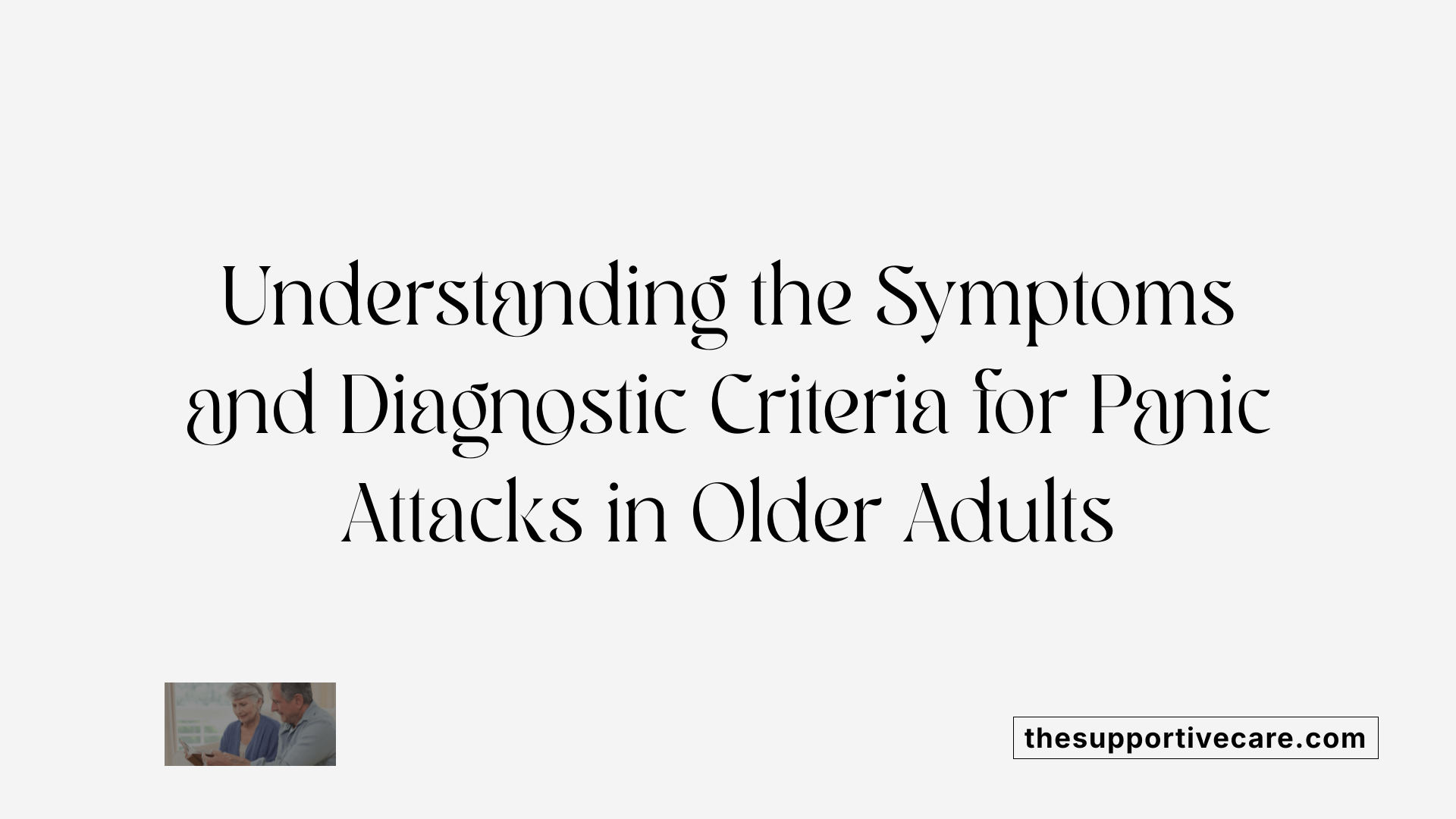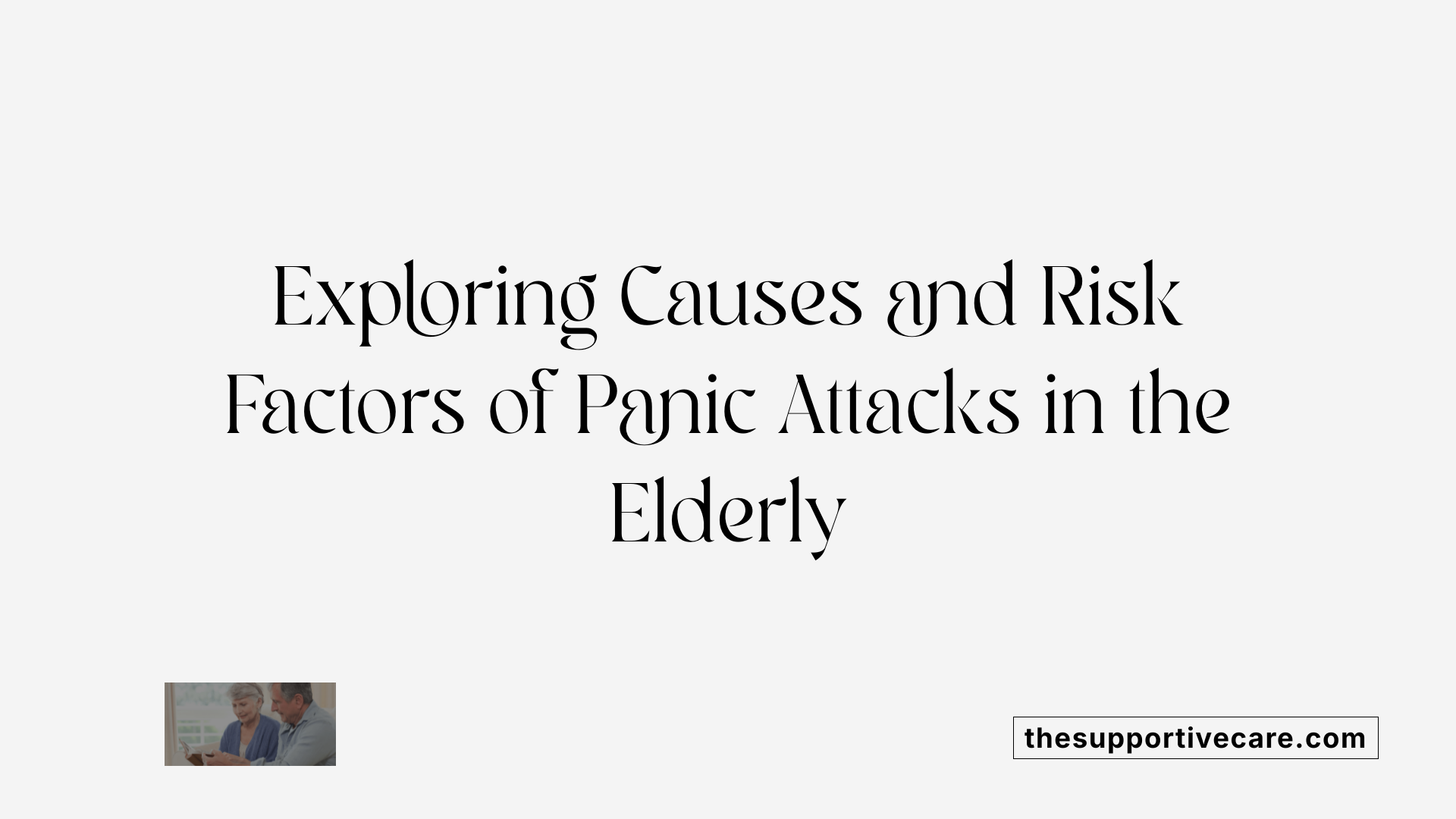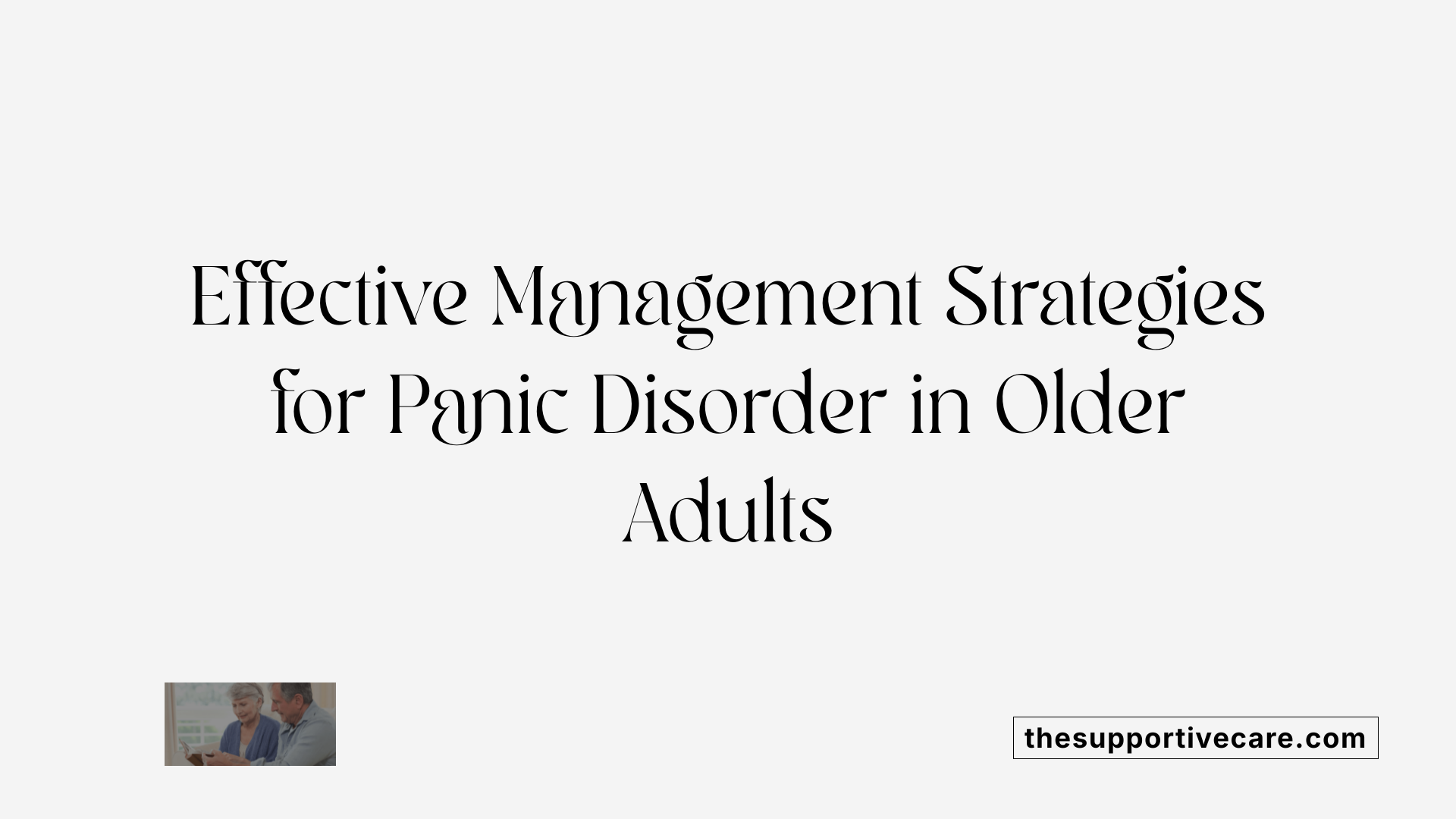Understanding Panic Disorder in the Elderly
Panic disorder, characterized by sudden surges of intense fear accompanied by physical symptoms such as rapid heartbeat, shortness of breath, and dizziness, is less frequently diagnosed in older adults compared to younger populations. Nonetheless, its impact on the elderly’s quality of life warrants careful attention. While panic attacks in seniors often mirror those seen in younger individuals, they tend to be fewer, less severe, and may involve less avoidant behavior. Recognizing these episodes, differentiating them from serious medical conditions like heart attacks, and understanding their unique presentation in older adults are crucial for effective management.
Symptoms and Diagnosis of Panic Attacks in Older Adults

What are the symptoms and diagnosis criteria for panic attacks in older adults?
Panic attacks in seniors are characterized by sudden episodes of intense fear and physical sensations. Common symptoms include a rapid heartbeat, sweating, trembling, shortness of breath, and chest pain or discomfort. Many older adults also experience nausea, dizziness, chills, heat sensations, tingling in the extremities, and feelings of depersonalization or derealization—an unsettling sense of unreality or detachment. These attacks are often accompanied by an overwhelming fear of losing control or dying.
These episodes typically reach peak intensity within minutes and can occur unexpectedly, even during rest or sleep. Because symptoms of panic attacks overlap with those of serious medical conditions like heart attacks, it is crucial to distinguish between them. For instance, symptoms such as chest pain and shortness of breath can mimic cardiac emergencies but are usually short-lived and resolve within about 20 minutes.
Diagnosing panic attacks involves a clinical evaluation considering the sudden onset of symptoms, their frequency, and the degree to which they disrupt daily life. Clinicians often use DSM-5 criteria, which specify that at least one attack is followed by persistent concern about future attacks or behavioral changes aimed at avoiding them, lasting for at least a month.
In older populations, these symptoms generally mirror those found in younger individuals but tend to be less severe or involve fewer avoidant behaviors. Accurate diagnosis is essential, as it guides appropriate treatment, which may include psychotherapy, primarily cognitive-behavioral therapy (CBT), and careful medication management. Proper assessment ensures differences from underlying medical conditions are clarified, preventing unnecessary interventions and facilitating tailored care.
Misconceptions Surrounding Panic Disorder Among Seniors

What are some common misconceptions or myths about panic disorder in older adults?
One prevalent myth is that panic disorder is a condition only affecting young or middle-aged people. Many believe that it is a normal part of aging, which leads to underdiagnosis among seniors. This misconception can cause older adults to endure symptoms silently, thinking they are just part of getting older, rather than recognizing them as treatable mental health issues.
Another widespread misunderstanding is that panic attacks are caused by serious medical conditions, such as heart attacks or strokes. While the physical symptoms of panic attacks—like chest pain, rapid heartbeat, and dizziness—are similar to those of cardiac events, they are generally not life-threatening and tend to resolve within about 20 minutes. Correct differentiation is crucial for appropriate management.
There is also a mistaken belief that panic attacks inevitably lead to fainting or extreme harm, which is rarely the case. Moreover, some assume that attacks are simply an overreaction to stress or anxiety, not recognizing that they can occur unexpectedly, without obvious triggers, and at any age.
Many assume that avoiding potential triggers or practicing only basic relaxation techniques like deep breathing can prevent attacks. While these strategies are helpful, comprehensive treatment often involves exposure therapy and cognitive-behavioral techniques that address underlying fears and maladaptive thought patterns.
Finally, a significant misconception is that panic disorder cannot be effectively treated in seniors. However, research and clinical experience show that older adults respond well to a combination of therapies—including medication and psychotherapy—similar to younger patients. Recognizing that panic disorder is a common, manageable condition at any age helps reduce stigma and encourages timely treatment seeking.
In summary, debunking these myths is essential to improve mental health outcomes for older adults. Increased awareness and understanding can lead to earlier diagnosis, better management, and ultimately, enhanced quality of life for seniors experiencing panic attacks.
Causes and Risk Factors for Panic Attacks in Seniors

What causes and risk factors are associated with panic disorder in seniors?
Panic disorder among older adults occurs less frequently than in younger populations and rarely begins for the first time in late life. In fact, most cases of panic attacks in seniors are linked to an earlier onset of the disorder, with late-onset occurrences being quite rare.
When panic attacks do begin in seniors, they tend to present with fewer symptoms that are less severe. These attacks often involve less avoidant behavior and may be characterized by physical symptoms like rapid heartbeat, shortness of breath, dizziness, and a sense of impending doom — similar to younger individuals but typically milder.
Several factors contribute to the development or exacerbation of panic attacks in the elderly. Biological causes include neurochemical imbalances and age-related physiological changes affecting nervous system functioning.
Psychological contributors such as pre-existing anxiety disorders, trauma history, or significant life transitions like retirement, bereavement, or loss of independence also play roles.
Medical illnesses prevalent in older adults, including chronic respiratory diseases such as COPD, cardiovascular conditions, thyroid disorders, and diabetes, can trigger panic episodes or mimic panic symptoms, making diagnosis more complex.
Additionally, certain medications common in the elderly, including steroids, stimulants, or other psychoactive drugs, may induce anxiety or panic symptoms as side effects.
Social stressors, especially significant life stress events like bereavement, social isolation, and ongoing health concerns, further increase vulnerability.
Managing panic disorder in this population requires careful treatment planning, considering the chronic or recurrent nature of the condition. Generally, pharmacologic options such as selective serotonin reuptake inhibitors (SSRIs), alongside cognitive behavioral therapy (CBT), are employed. Treatment strategies are tailored based on individual health status, comorbidities, and preferences.
In essence, the causes of panic attacks in seniors are multifaceted, involving a complex interplay of biological, psychological, medical, and social factors that necessitate a comprehensive and personalized approach to care.
Management Strategies for Panic Disorder in the Elderly

What treatment options are available for managing panic disorder in the elderly, including both pharmacological and non-pharmacological approaches?
Managing panic disorder in older adults requires a careful and personalized approach that combines medication and psychotherapeutic strategies, factoring in individual health conditions, existing comorbidities, and patient preferences.
Pharmacological treatments are commonly used, with selective serotonin reuptake inhibitors (SSRIs) such as sertraline, fluoxetine, and paroxetine usually considered first-line options. These medications are preferred over benzodiazepines due to their better safety profile in older adults. When initiating antidepressants, clinicians typically start at a low dose and gradually increase it to improve drug tolerability and adherence.
In some cases, short-term use of benzodiazepines like lorazepam may help alleviate acute symptoms during the initial phase of treatment. However, caution is essential since long-term benzodiazepine use can lead to adverse effects such as cognitive impairment, falls, and dependence.
Non-pharmacological interventions, particularly cognitive-behavioral therapy (CBT), have proven highly effective for panic disorder in the elderly. CBT focuses on changing maladaptive thoughts, reducing avoidance behaviors, and teaching relaxation techniques. These approaches can significantly reduce the intensity and frequency of panic attacks and their impact on daily life.
Complementary strategies such as mindfulness, breathing exercises, and stress management techniques are also beneficial when incorporated into a comprehensive treatment plan.
Before starting any treatment, healthcare providers perform a thorough assessment to exclude other underlying causes that mimic panic symptoms, including depression, physical illnesses like cardiac or respiratory conditions, or medication side effects.
In summary, treatment should be tailored to each individual, balancing efficacy and safety. It often involves an integrated approach combining medication, psychotherapy, lifestyle modifications, and social support, all aimed at improving the overall quality of life for older adults facing panic disorder.
Long-term treatment considerations
Long-term management is essential as panic disorder tends to be recurrent and chronic in many older adults. Regular follow-up and monitoring for medication side effects, especially in polypharmacy situations common in the elderly, are necessary. Adjustments to therapy may be needed over time, and ongoing psychological support can help maintain improvements achieved.
Personalization and safety in medication use
Medication choices are made cautiously, beginning with lower dosages of SSRI or SNRI agents, with careful monitoring of efficacy and adverse effects. Consideration of drug interactions, renal and hepatic function, and the presence of other mental or physical health issues informs treatment decisions. Non-medication strategies are emphasized to minimize risks associated with pharmacotherapy.
Effective management of panic disorder in older adults hinges on a patient-centered paradigm that integrates pharmacological safety, evidence-based psychotherapy, and supportive care, ensuring a comprehensive strategy tailored to each elderly patient's needs.
Efficacy of Evidence-Based Therapies in the Elderly
How effective are evidence-based therapies, such as cognitive-behavioral therapy, in managing panic disorder in older adults?
Research consistently shows that cognitive-behavioral therapy (CBT) is highly effective in treating panic disorder in older adults. Clinical studies, including randomized controlled trials, have demonstrated significant reductions in panic attack frequency, severity, and related avoidance behaviors after CBT interventions. Older patients often experience improvements in panic-related cognitions, physiological arousal, and comorbid depression.
A study conducted in the Netherlands involving adults aged 55 and above with panic disorder found that participants who underwent tailored CBT had notable symptom improvements. These gains were not only immediate but were maintained during follow-up assessments three months post-treatment. Importantly, the therapy appeared to produce even greater reductions in avoidance behaviors compared to younger cohorts, possibly reflecting the therapy’s adaptability to older adults’ specific needs.
When adapting CBT for older populations, clinicians often extend session durations, incorporate visual aids, and emphasize explicit learning strategies to accommodate age-related cognitive and sensory changes. These modifications enhance engagement and comprehension. The supportive, skills-based approach helps older adults confront and manage fear-provoking situations, reducing the likelihood of future panic episodes.
The long-term benefits, reflected in sustained symptom relief and improved quality of life, underscore CBT’s role as a credible, evidence-based treatment. The therapy’s accessibility, especially when delivered via telehealth or in community settings, makes it a valuable option as part of a comprehensive treatment plan.
Tailoring CBT for older adults
Tailoring CBT for the elderly involves addressing unique challenges such as hearing or vision impairments, cognitive decline, and mobility issues. Therapists often use larger visual materials, simplified language, and shorter, more frequent sessions to enhance effectiveness. Explicitly teaching coping skills and involving family or caregivers can support ongoing practice and reinforce gains.
In-person therapy remains effective, but teletherapy has also become increasingly relevant, providing additional comfort and accessibility. The goal is to build a trusting therapeutic relationship while adapting techniques to respect the physical and cognitive capacities of older adults.
Long-term benefits and follow-up
Follow-ups are critical in sustaining treatment effects. Studies indicate that older adults who complete CBT often experience continued improvements for months after therapy concludes. Reinforcing strategies during follow-up sessions and encouraging regular practice of learned skills help prevent relapse.
Furthermore, combining CBT with medication, when appropriate, can enhance long-term outcomes, especially for individuals with severe symptoms or comorbid conditions. Regular monitoring, ongoing support, and booster sessions can maintain the gains achieved through therapy.
Overall, the evidence underscores that CBT, when tailored to meet the specific needs of older adults, is a highly effective, sustainable treatment for managing panic disorder, significantly improving their mental health and daily functioning.
Clinical Guidelines and Care Considerations
What clinical guidelines and considerations should be taken into account when treating panic disorder in the aging population?
Managing panic disorder in older adults requires a comprehensive, cautious, and personalized approach. Clinicians should be aware of the unique physiological and medical features of aging, which influence both the presentation of panic symptoms and the response to treatment.
One of the primary considerations is understanding and accounting for age-related changes in pharmacokinetics and pharmacodynamics. Reduced liver and kidney function can alter drug absorption, metabolism, and excretion, increasing the risk of side effects. Starting treatment with lower doses, such as about half the typical dosage used in younger populations, and gradually titrating upwards can improve tolerance and adherence.
It is also crucial to conduct a thorough assessment for comorbidities. Many older adults experience physical illnesses such as cardiovascular disease, respiratory conditions like COPD, diabetes, or neurodegenerative disorders like dementia, which can mimic or complicate panic symptoms. Additionally, clinicians should evaluate for depressive symptoms, substance use, or side effects of current medications, as these can contribute to or exacerbate panic symptoms.
Given the recurrent and often chronic nature of panic disorder in the elderly, a long-term management plan that combines both pharmacotherapy and psychotherapy is ideal. Selective serotonin reuptake inhibitors (SSRIs) are generally preferred over benzodiazepines as the first-line medication due to a more favorable safety profile, reducing risks such as cognitive impairment, falls, and dependence.
Cognitive-behavioral therapy (CBT) is a well-established psychological intervention that is effective in reducing panic symptoms, and evidence suggests it can be as beneficial in older adults as in younger populations. Incorporating relaxation techniques, mindfulness practices, and lifestyle modifications such as exercise and social engagement can further support treatment.
Safety and ongoing monitoring are paramount. Regular follow-up allows clinicians to evaluate treatment effectiveness, adjust dosages, and identify adverse effects early. Monitoring should include assessment of mental health, physical health, medication adherence, and potential interactions with existing conditions or treatments.
Finally, treatment planning should be highly individualized, taking into account the patient's preferences, social support networks, financial situation, and access to skilled mental health professionals. Personalized care increases the likelihood of treatment success and improves overall quality of life.
In summary, effective management of panic disorder in the elderly involves careful assessment of comorbidities, cautious medication use, integration of psychotherapy and lifestyle strategies, and vigilant safety monitoring—all tailored to the individual's health status and circumstances.
Outcomes and Treatment Efficacy in the Elderly
What are the typical outcomes and treatment efficacy rates for elderly patients with panic disorder?
Elderly patients diagnosed with panic disorder often experience meaningful improvements in symptoms when they receive proper treatment. Many respond well to therapy and medication, with significant reductions in panic attack frequency and severity. However, the response can vary considerably depending on individual factors such as overall health, presence of other medical or psychiatric conditions, medication adherence, and social support.
Pharmacologically, selective serotonin reuptake inhibitors (SSRIs) like escitalopram, citalopram, sertraline, and paroxetine are commonly prescribed as their safety profile is favorable for older adults. These medications have demonstrated efficacy in reducing panic symptoms, with some studies indicating comparable response rates to younger populations. Serotonin-norepinephrine reuptake inhibitors (SNRIs) such as venlafaxine are also effective options.
Cognitive-behavioral therapy (CBT) has shown promising results, with studies indicating significant symptom improvement. However, the evidence base is limited, primarily comprising small pilot studies or case series, and there's a lack of large-scale randomized controlled trials (RCTs). When comparing pharmacotherapy alone versus combined therapy, findings suggest that both approaches can be effective, and no treatment class has consistently outperformed the other in older adults.
Treatment success is assessed through symptom monitoring, response rates (typically defined as a substantial decrease in panic attack frequency), and remission. Starting medications at low doses and gradually titrating upward helps improve tolerability and adherence, which are crucial for achieving optimal outcomes.
While conclusive efficacy rates are difficult to specify due to the scarcity of high-quality research, existing evidence indicates that tailored, patient-centered approaches—integrating medication, psychotherapy, and lifestyle modifications—are associated with favorable outcomes. These combined strategies help maximize benefits while minimizing risks, especially important given the complexities of medical comorbidities common in the elderly.
Impact of comorbidities and adherence
Many older adults with panic disorder also contend with other health issues such as cardiovascular conditions, respiratory diseases, or cognitive decline. These comorbidities can influence both the presentation of panic attacks and the response to treatment. For example, physical health problems may mimic or exacerbate panic symptoms, complicating diagnosis.
Adherence to treatment regimens tends to be lower in this population, often due to side effects, concerns about medication interactions, or difficulty with therapy attendance. Careful management—including starting medications at low doses, regular follow-up, and patient education—can help enhance adherence.
Research gaps and need for further studies
Despite some evidence supporting the use of medications and CBT in treating panic disorder among older adults, there remains a significant gap in high-quality research. Most available studies are small-scale, and their findings may not be generalizable. Large randomized controlled trials are necessary to establish definitive efficacy rates, optimize treatment protocols, and understand the long-term outcomes in this age group.
Furthermore, research should explore the impact of specific comorbidities, polypharmacy concerns, and social factors on treatment response. Developing age-specific and culturally sensitive interventions will be vital to improving care.
In conclusion, while current treatments can significantly improve quality of life for seniors with panic disorder, more rigorous research is essential to refine and personalize therapeutic strategies to maximize their effectiveness.
Tailored Management Strategies for Older Adults
Are there specific management strategies tailored to older adults with panic disorder?
Managing panic disorder in the elderly requires a personalized approach that considers the unique physiological, psychological, and social circumstances of older patients. Since panic attacks in seniors are often associated with comorbidities such as cardiovascular or respiratory illnesses, as well as medication effects, treatment plans must be carefully designed.
Pharmacologic treatment generally favors the use of antidepressants, especially selective serotonin reuptake inhibitors (SSRIs), over benzodiazepines due to their safer profile. Starting doses are typically low, with gradual titration, to minimize side effects and improve adherence. For some patients, short-term adjunctive use of medications like lorazepam can provide initial relief, but long-term benzodiazepine use is discouraged given risks such as dependence, cognitive impairment, and falls.
Psychotherapy, particularly cognitive-behavioral therapy (CBT), is strongly recommended and has demonstrated efficacy in reducing panic symptoms in older adults. Tailoring therapy to account for potential cognitive decline, sensory impairments, and mobility issues enhances its effectiveness.
Monitoring is a vital component; regular assessment of symptom severity, medication side effects, and overall functioning helps prevent relapse and manage comorbid conditions like depression or physical health problems that can mimic or worsen panic episodes.
An integrated, multidisciplinary approach combining medical, psychological, and social interventions is optimal. This includes coordinating care among primary care providers, mental health specialists, and social workers to address the broad spectrum of factors influencing panic disorder.
In conclusion, effective management hinges on a comprehensive, patient-centered strategy that emphasizes safety, individual preferences, and ongoing evaluation, drawing from evidence primarily developed in younger populations and adapted for the elderly. This approach aims to improve quality of life, reduce attack frequency, and manage associated health concerns.
Enhancing Care for Older Adults with Panic Disorder
Effective treatment of panic disorder in the elderly requires a comprehensive, individualized approach that combines pharmacotherapy—preferably with SSRIs—and evidence-based psychotherapy such as cognitive-behavioral therapy. Recognizing the unique presentation of panic attacks in older adults, ensuring accurate diagnosis, and differentiating from medical conditions are essential first steps. Management should also incorporate lifestyle modifications, social support, and caregiver involvement to improve outcomes. While high-quality research specific to this population remains limited, current evidence suggests that with appropriate care and monitoring, older adults can experience significant symptom relief and an improved quality of life. Continued research and tailored guidelines will enhance our ability to effectively treat panic disorder within this growing demographic.
References
- Diagnosis and management of panic disorder in older patients
- Understanding and Managing Panic Attacks in Seniors
- Anxiety and Older Adults: Overcoming Worry and Fear
- Generalized Anxiety Disorder and Panic Disorder in Adults - AAFP
- Recognizing and Managing Panic Attacks in Older Adults - Talkspace
- Anxiety and Older Adults: A Guide to Getting the Relief You Need
- Cognitive-Behavioral Therapy in Older Panic Disorder Patients
- Anxiety in the Golden Years: What You Should Know | Cedars-Sinai
- COGNITIVE‐BEHAVIORAL THERAPY FOR PANIC DISORDER ...
- Treatment of Anxiety Disorders in the Elderly: Issues and Strategies



































































































